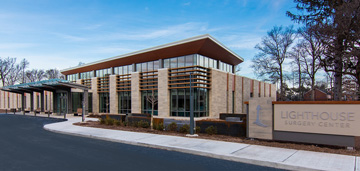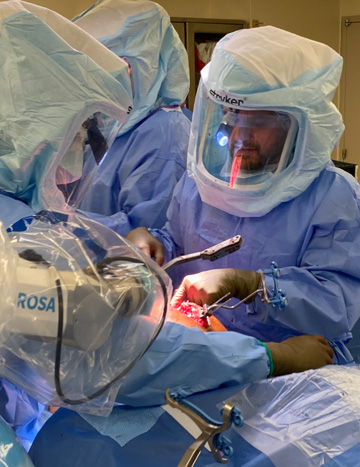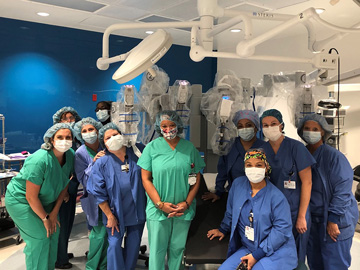The critical partnership that led to the successful transition of inpatient total joint surgeries at the Lighthouse Surgery Center.
 CREDIT: Lighthouse Surgery Center
CREDIT: Lighthouse Surgery Center
Three years ago, Michael Joyce, MD, noticed total joint replacement patients were mobilizing more quickly than in the past. Advanced surgical technology and new pain management techniques meant patients had shorter recovery times and hospital stays. Dr. Joyce and his colleagues began to perform some of their total joints as outpatient procedures at the hospital to develop an efficient process for patient selection, surgical flow and postoperative discharge.
The surgeons also collaborated with anesthesiologists to use long-acting local anesthetics and limit narcotic use, so patients would be discharged home in relative comfort. The last step was having patients undergo their initial physical therapy shortly after surgery.
The process worked, and after successfully performing outpatient total joints for several years at the hospital, the surgeons decided it was time to take their cases to an ASC.
Dr. Joyce and his partners collaborated with St. Francis Hospital to develop a Lighthouse Surgery Center in Hartford, Conn., with assistance from outside vendors, including Stryker. Dr. Joyce had used Stryker implants for more than 25 years, but as he worked to develop the new ASC, Stryker was much more than a pure implant vendor. They became a true partner, providing guidance for inventory management and design advice based on best practices.
"I think of Stryker now as a company that provides both products and services to help make your ASC a reality," says Dr. Joyce. "Having Stryker come to the table with so many different ideas gave us a higher degree of expertise."
Steps to success
Over the past three years, the surgeons saw the volume of outpatient cases grow from dozens to hundreds annually. Then, COVID-19 accelerated the migration of total joints to the ASC. "Patients didn't want to be in the hospital," says Dr. Joyce. "We were COVID-free and became a safe alternative."
To move a high volume of total joints from the inpatient hospital to the outpatient ASC setting, organizations need strong leadership to build a collaborative culture, says Dr. Joyce. Surgeons must have the ability to discuss challenges with each other and the larger surgical team, especially if they are coming from separate independent clinical practices.
The sterile processing department at the ASC plays a critical role in the success of a total joint program. "Sterile processing has to be robust," says Dr. Joyce. So CJRI built a sterile processing department that was similar to the hospital's department, with the same policies, procedures and standards of care. Among the first 300 TJA's patients at the surgery center, there were no hospital admissions, and the current infection rate is well below 1 percent.
The stellar outcomes and low infection rate at Lighthouse Surgery Center aren't an accident. Dr. Joyce and his partners put in 18 months of planning and careful research to develop the surgery center. "This isn't something you can do shooting from the hip," he says, "You can't avoid the long-term planning."
Dr. Joyce said Stryker was helpful in planning out the sterile processing workflow and inventory management system at the ASC. Inventory management is different at an ASC because centers can't keep as many instrument trays on hand as hospitals do.
"Stryker has a breadth of experience working with centers across the country, and as we started to face some of the development challenges of building an ASC, they were a point of contact for us to collaborate with other centers that faced similar issues," says Dr. Joyce. "We created a culture of collaboration where they helped us meet some of our design, billing and operational challenges. Stryker was instrumental in all phases of developing the ASC."
A promising future
When Dr. Joyce first began performing outpatient total joints, patients were skeptical. Now, patients are asking for surgery in the ASC. They are motivated to recover from surgery quickly and return to normal activity.
"You can't deter a motivated patient," he says. "People now come in and tell us they are exactly the right person for an outpatient total joint."
The motivated patients bode well for continued ASC industry growth. Dr. Joyce and his partners see the value in performing more total joints in a physician-owned setting.
"Health organizations are getting very large," he says. "I think surgeons, who are ultimately face-to-face with patients and care for the patients, feel that our ability to dictate important elements of their care is being diluted by larger bureaucracy of the big organizations. With our ASC, we have operational control."
"There are a lot of avenues where innovation is found and brought to us, and we don't have a barrier to entry," says Dr. Joyce. "That's something we all believe in strongly, and if the technology is reasonably priced, we work with surgeons to bring it to the center and evaluate it. Our goal is to make surgeons' lives easier, and we can do that."
Note: Dr. Joyce is a paid consultant of Stryker's ASC business. The opinions expressed by Dr. Joyce are those of Dr. Joyce and not necessarily those of Stryker. Individual experiences may vary.
Note: For more information about Stryker's ASC business, please go here.
 AFFORDABLE OPTION Medicare beneficiaries should be able to have procedures done in facilities that save the U.S. health system billions of dollars.
AFFORDABLE OPTION Medicare beneficiaries should be able to have procedures done in facilities that save the U.S. health system billions of dollars.
.svg?sfvrsn=be606e78_3)



.svg?sfvrsn=56b2f850_5)